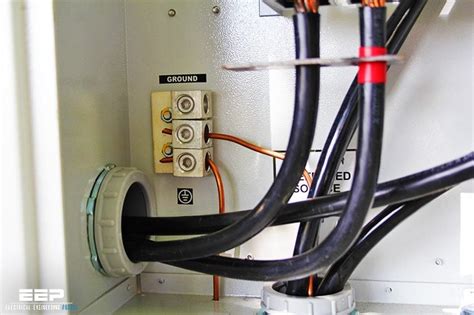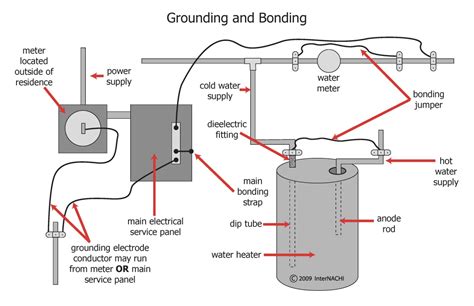lv bonding electrical | bonding electrical panels home lv bonding electrical Best practices for GIS grounding and bonding include the following: Practice #1 – All grounding conductors should be as short as possible. Practice #2 – The grounding mesh and interconnections should be capable of carrying the system’s fault currents without exceeding the thermal and mechanical limits. User ratings: 10. Key specs. Brightness (max): 1200 lm. Noise level: , 32 dB. Go to full specs. Add to compare. Canon - Video Reviews (1) powered by. Add video review. Canon LV-S3 LCD Projector Demo. Multideals. Canon LV-S3 - Full Specifications. Units: Metric. Imperial. Technical details. Noise level. < 32. Optics. Image. Brightness (max)
0 · ungrounded electrical bonding requirements
1 · how to bonding house wiring
2 · grounding and bonding of wiring
3 · electrical grounding and bonding
4 · electrical bonding requirements
5 · bonding of electrical systems
6 · bonding home wiring systems
7 · bonding electrical panels home
Canon LV-S3. Download software, firmware and manuals and get access to troubleshooting resources for your projector. Software. Manuals. Firmware. FAQs & Help. Software (0) Software is an optional download that enables advanced functionality and helps you to get the most out of your product.
Best practices for GIS grounding and bonding include the following: Practice #1 – All grounding conductors should be as short as possible. Practice #2 – The grounding mesh and interconnections should be capable of carrying the system’s fault currents without exceeding .This paper focuses on considerations on achieving an optimally safe and (power .Bonding and grounding explained. All home electrical systems must be bonded and .
Best practices for GIS grounding and bonding include the following: Practice #1 – All grounding conductors should be as short as possible. Practice #2 – The grounding mesh and interconnections should be capable of carrying the system’s fault currents without exceeding the thermal and mechanical limits.
Bonding and grounding explained. All home electrical systems must be bonded and grounded according to code standards. This entails two tasks: First, the metal water and gas pipes must be connected electrically to create a continuous low resistance path back to the main electrical panel.Low-voltage high resistance grounding system basics. Introduction. Grounding is commonly used in the electrical industry to mean an intentional connection to earth of conductive materials either solidly or through impedance. System grounding: Intentional connection to earth of the neutral points of the current carrying conductors. Understand National Electrical Code grounding and bonding requirements for solidly grounded alternating current low-voltage systems (below 1,000 volts). Prevent common grounding and bonding design and construction errors.
Think of grounding and bonding as the foundation of a safe electrical installation. Section 250.4 lays out the performance requirements of grounding and bonding electrical systems. The rest of Article 250 covers how to achieve this desired level of protection. This paper focuses on considerations on achieving an optimally safe and (power system) optimal reliable bonding and earthing of a wood pole structure that carries MV, LV and other services at the same time. This article offers an overview of the content of each one of those 10 parts. Applying the rules for grounding and bonding requires in-depth study and familiarity by electrical workers with the rules, their exceptions, the associated tables, their notes, and the use of informational notes.How to Design System Grounding in Low Voltage Electrical Systems – E05-016 2 - Lightning impulse withstand voltage (1.2; 50ms wave); - Insulating voltage (highest network voltage); and - Power frequency withstand voltage (2 U + 1,000 V/1mn). Example for a LV type switchboard: - Insulating voltage: 1,000 V - Impulse voltage: 12 kV
While grounding and bonding might seem like the same thing, they have some very important differences. Electrical bonding is the practice of connecting metallic objects that may be exposed to electrical faults or induced voltages to the grounding conductor.
ungrounded electrical bonding requirements

Ultimately, the purpose of the bonding infrastructure is to aid in equalizing potentials during lightning strikes, electrical system fault, electrical static discharge, radio frequency interference (RFI), and electromagnetic interference (EMI). Best practices for GIS grounding and bonding include the following: Practice #1 – All grounding conductors should be as short as possible. Practice #2 – The grounding mesh and interconnections should be capable of carrying the system’s fault currents without exceeding the thermal and mechanical limits.
rolex online dealer
Bonding and grounding explained. All home electrical systems must be bonded and grounded according to code standards. This entails two tasks: First, the metal water and gas pipes must be connected electrically to create a continuous low resistance path back to the main electrical panel.Low-voltage high resistance grounding system basics. Introduction. Grounding is commonly used in the electrical industry to mean an intentional connection to earth of conductive materials either solidly or through impedance. System grounding: Intentional connection to earth of the neutral points of the current carrying conductors. Understand National Electrical Code grounding and bonding requirements for solidly grounded alternating current low-voltage systems (below 1,000 volts). Prevent common grounding and bonding design and construction errors.
Think of grounding and bonding as the foundation of a safe electrical installation. Section 250.4 lays out the performance requirements of grounding and bonding electrical systems. The rest of Article 250 covers how to achieve this desired level of protection. This paper focuses on considerations on achieving an optimally safe and (power system) optimal reliable bonding and earthing of a wood pole structure that carries MV, LV and other services at the same time. This article offers an overview of the content of each one of those 10 parts. Applying the rules for grounding and bonding requires in-depth study and familiarity by electrical workers with the rules, their exceptions, the associated tables, their notes, and the use of informational notes.
how to bonding house wiring
How to Design System Grounding in Low Voltage Electrical Systems – E05-016 2 - Lightning impulse withstand voltage (1.2; 50ms wave); - Insulating voltage (highest network voltage); and - Power frequency withstand voltage (2 U + 1,000 V/1mn). Example for a LV type switchboard: - Insulating voltage: 1,000 V - Impulse voltage: 12 kVWhile grounding and bonding might seem like the same thing, they have some very important differences. Electrical bonding is the practice of connecting metallic objects that may be exposed to electrical faults or induced voltages to the grounding conductor.

grounding and bonding of wiring


rolex on dick meme
rolex one love
We have 4 Canon LV S3 - SVGA LCD Projector manuals available for free PDF download: Owner's Manual, Specification, Assembly & Installation Manual, Brochure & Specs. Canon LV S3 - SVGA LCD Projector Owner's Manual (52 pages) Canon LV-S3: Owners Manual. Brand: Canon | Category: Projector | Size: 3.33 MB. Table of Contents. To the Owner. 2.
lv bonding electrical|bonding electrical panels home


























